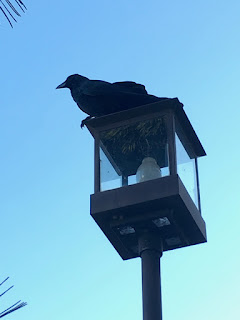Let's talk about crows.
Japan has two native species of crows, with the most common being the large-billed crow (Corvus macrorhynchos japonensis). They can easily reach 60 cm (23 inches) long -- and, as a result, are often mistaken for ravens.
 |
| A corvid emperor surveying his domain. |
They're also fairly aggressive--so much so that some places even have warning signs posted in Japanese and English warning people to "beware of crows." (A note: the warning is primarily designed to ensure people don't get mugged--an experience you won't quickly forget, and one I've shared in a previous MIE post.)
 |
| A mug(ger) shot from my past. |
In Japan, the crow is revered as a harbinger and messenger of Amaterasu Omikami, the chief deity in the Shintō pantheon. Her primary messenger, the divine three-legged crow called Yatagarasu, is reported to have led Jimmu, the first emperor of Japan, to the place where he assumed the Chrysanthemum Throne.
 |
| Jimmu and Yatagarasu - the crow as messenger of the divine. |
The crows of Japan certainly seem to remember their place in the divine order; they are brash, self-confident, and loud enough to be heard several blocks away when arguing with their brethren--and believe me, they argue constantly.
My apartment sits approximately a block from a park with a bamboo grove and a block and a half from a Shintō shrine. We have resident murders (of crows) in both locations, and I hear them at almost any and every hour of the day and night. (Fortunately, I like their calls.)
 |
| Attempted murder, anyone? |
During this time of coronavirus isolation, I've resumed a practice I began about a year ago--attempting to win the trust of one of the larger local crows. He likes to sit on the TV antenna and roof of the house next door, and I'd noticed him watching both Oobie and me through the window.
On a whim, I placed a cookie on the balcony ledge. After I closed the door, he swooped in to take it. He's a clever fellow, and it only took him about two days to realize I'd resumed the cookie offerings. We've been at it for almost a month now, and he knows that the cookie goes out between 9 and 10 am. He hasn't quite decided whether he's stealing it or not (a critical first step in winning his trust) but he's happy to come and take it either way.
 |
| Hachi coming in for his treat. |
For my part, I'm happy to have a visitor who understands the idea of social distancing.
The crow (who I've named "Hachi"--which means "eight," and is a Japanese play on "Yatagarasu"--the "eight span crow") has brightened someone else's days as well: my cat, Oobie, loves to watch Hachi get his cookie, and waits for him by the window every morning.
 |
| The cookie grab. |
It gives all of us (including Hachi) something to look forward to - and although I hope the social distancing measures will be lifted sooner rather than later (hey, a girl can dream) my "visits" with Hachi are making the days a little brighter in the meantime.
So tell me . . . what are you doing to amuse yourself during quarantine?






















